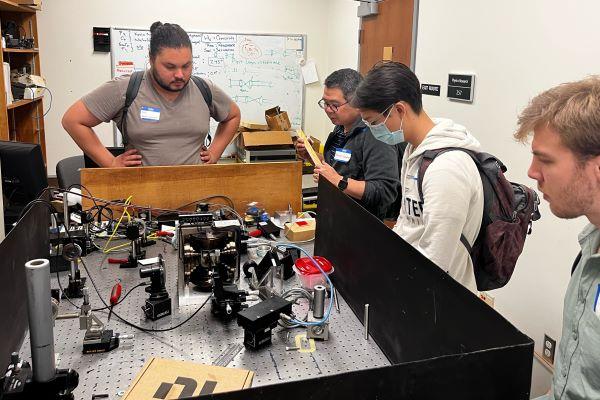Ohio State Center for Emergent Materials receives NSF funding for research and education partnership

The Center for Emergent Materials (CEM) at The Ohio State University’s College of Arts and Sciences is partnering with California State University, Long Beach (CSULB) on a program to expand participation and access to materials science facilities, education, training and careers. Funded by the National Science Foundation (NSF), Partnerships for Research and Education in Materials (PREM) awards are intended to broaden access to skills and opportunities by supporting strategic partnerships between minority-serving institutions and NSF-funded research centers at research-intensive institutions.
The $4.2 million PREM award leverages CSULB's status as an urban Hispanic-serving institution to build educational pathways at the undergraduate and graduate levels, including post-bachelors bridge programming into technology careers and a research-based Master of Sciences degree. The program’s research is focused on exploring applications in magnetic storage, energy-efficient devices and bio-inspired materials.
CEM previously received NSF seed funding to develop the partnership with CSULB, leveraging the CEM summer Research Experience for Undergraduates (REU) program and the MS-to-PhD Physics Bridge programs at both institutions to build collaborative research projects.
“The PREM seed award helped us grow a new class of topological magnetic materials, and with CSULB collaborator Prof. Claudia Ojeda-Aristizabal, probe their electronic band structure through photoemission measurements at Lawrence Berkeley National Laboratory,” said co-PI Joshua Goldberger, Charles H. Kimberly Professor in the Department of Chemistry and Biochemistry and director of the Center for Emergent Materials. “This wouldn’t have been possible without the seed award.” This new award will expand these connections to other research topics.
CEM scientists work in teams to tackle nanoscale materials science problems too complex for researchers to solve alone. PREM expands the collaborative nature of this work by combining complementary expertise from CSULB and Ohio State in projects ranging from ultra-fast and energy-efficient computing to next-generation electronic devices.
At CSULB, the new PREM awards will support specialized training and mentorship for students and early-career researchers, new research faculty positions, expanded educational outreach to local high school students and teachers, and other activities to build pathways for the future materials research workforce, in addition to fundamental materials research projects. The goal is for students to complete their degrees and progress into STEM PhD programs or industry careers, which also aligns with Ohio State’s forward-looking focus on semiconductor and other technology professions.
“Research in Ohio was exciting and challenging,” said Joshua Luna, a physics major at CSULB. “[The REU program] strengthened my foundational skills and without a doubt turned me from a clueless freshman to a relatively competent 2D materials researcher. I learned how to pose questions for projects, maneuver around shortages and to roll with the challenges that come with research. As a result, I believe I gained the skills to gain access to opportunities that I only dreamt of before.”
The PREM co-principal investigators at Ohio State are Goldberger and Jay Gupta, professor in the Department of Physics. CSULB is represented by Michael Peterson and Jiyeong Gu, professors of physics and astronomy, as well as mathematics professor Ryan Blair.
